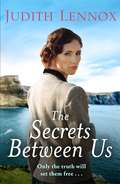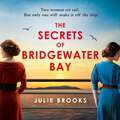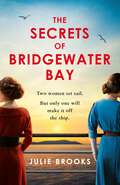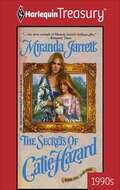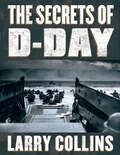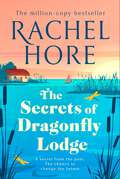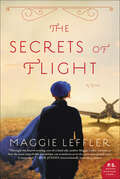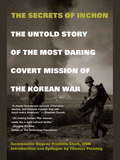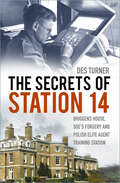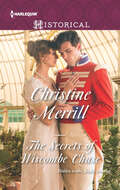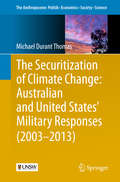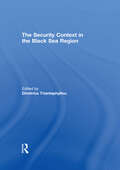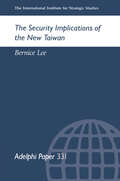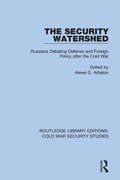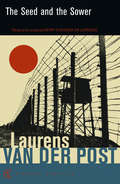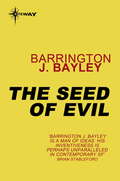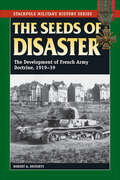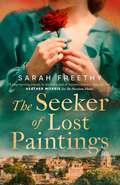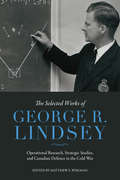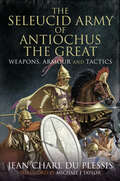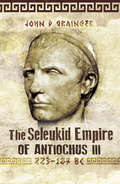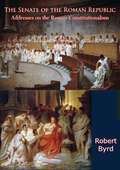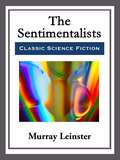- Table View
- List View
The Secrets Between Us
by Judith LennoxA breathtaking and tumultuous love story of the secrets, hidden passions and loyalties that bind us together. THE SECRETS BETWEEN US is the latest mesmerising tale of drama and intrigue from Judith Lennox, the author of HIDDEN LIVES and THE JEWELLER'S WIFE. Not to be missed by readers of Rachel Hore and Kate Morton. 'I have fallen completely in love with Judith Lennox's writing - she's a fantastic storyteller!' Jill Mansell It is Christmas 1937 when sisters Rowan and Thea travel from London to Scotland to visit their dying father. Having lost their mother in a tragic sailing accident when they were young, the two women are accustomed to grief. But they have no idea that their father's death will expose a terrible deception... For back in London is his wife Sophie and their two sons. Neither family knows of the other's existence, and when news reaches Sophie of Hugh's death her whole world is turned upside down. Meanwhile, Rowan's marriage is crumbling, and Thea reluctantly finds herself acting as a go-between for her sister and her lover. But, with the onslaught of World War II, the lives of all three women will change for ever. And they must confront the secrets between them before they can seize their chance of happiness...
The Secrets Between Us
by Judith LennoxA breathtaking and tumultuous love story of the secrets, hidden passions and loyalties that bind us together. THE SECRETS BETWEEN US is the latest mesmerising tale of drama and intrigue from Judith Lennox, the author of HIDDEN LIVES and THE JEWELLER'S WIFE. Not to be missed by readers of Rachel Hore and Kate Morton. 'I have fallen completely in love with Judith Lennox's writing - she's a fantastic storyteller!' Jill Mansell It is Christmas 1937 when sisters Rowan and Thea travel from London to Scotland to visit their dying father. Having lost their mother in a tragic sailing accident when they were young, the two women are accustomed to grief. But they have no idea that their father's death will expose a terrible deception... For back in London is his wife Sophie and their two sons. Neither family knows of the other's existence, and when news reaches Sophie of Hugh's death her whole world is turned upside down. Meanwhile, Rowan's marriage is crumbling, and Thea reluctantly finds herself acting as a go-between for her sister and her lover. But, with the onslaught of World War II, the lives of all three women will change for ever. And they must confront the secrets between them before they can seize their chance of happiness...
The Secrets of Bridgewater Bay: A darkly gripping dual-time novel of family secrets to be hidden at all costs...
by Julie BrooksTwo women set sail for Australia, bound by a terrible truth. But only one will make it off the ship.The Secrets of Bridgewater Bay is a darkly gripping dual-time novel, with a wealth of twists, turns and secrets, and an absolute book club treat, perfect for fans of Lucinda Riley, Rachel Rhys and Hannah Richell.'A sweeping tale of family secrets, betrayal, jealousy, ambition and forbidden romance . . . Fans of The Thorn Birds and Downton Abbey will love the epic scope of this novel' ALI MERCER'I thoroughly enjoyed this immersive story which spans both generations and continents. The evocative details and impeccable research make for a delightful reading experience and I can pay it no greater compliment other than to say, I wish I'd written it' KATHRYN HUGHES'This is an epic dual-time novel which draws the reader in right from the start and keeps you in thrall until the very last page. The writing is superb, the descriptions detailed, lush and evocative' CHRISTINA COURTENAY'A gripping story full of family secrets: the price of love and loss within two generations . . . convincing and poignant' LEAH FLEMING'Rich in evocative detail - the complex mystery kept me guessing right up to the last page' MUNA SHEHADI......................................................................................................England, 1919: Rose and Ivy board a ship bound for Australia. One is travelling there to marry a man she has never met. One is destined never to arrive.Australia, 2016: Amongst her late-grandmother's possessions, Molly uncovers a photograph of two girls dressed in First World War nurses' uniforms, labelled 'Rose and Ivy 1917', and a letter from her grandmother, asking her to find out what happened to her own mother, Rose, who disappeared in the 1960s. Compelled to carry out her grandmother's last wish, Molly embarks on a journey to England to unravel the mystery of the two girls whose photograph promised they'd be 'together forever'...(P) 2021 Headline Publishing Group Ltd.
The Secrets of Bridgewater Bay: A darkly gripping dual-time novel of family secrets to be hidden at all costs...
by Julie BrooksTwo women set sail for Australia, bound by a terrible truth. But only one will make it off the ship.The Secrets of Bridgewater Bay is a darkly gripping dual-time novel, with a wealth of twists, turns and secrets, and an absolute book club treat, perfect for fans of Lucinda Riley, Rachel Rhys and Hannah Richell.'A sweeping tale of family secrets, betrayal, jealousy, ambition and forbidden romance . . . Fans of The Thorn Birds and Downton Abbey will love the epic scope of this novel' ALI MERCER'I thoroughly enjoyed this immersive story which spans both generations and continents. The evocative details and impeccable research make for a delightful reading experience and I can pay it no greater compliment other than to say, I wish I'd written it' KATHRYN HUGHES'This is an epic dual-time novel which draws the reader in right from the start and keeps you in thrall until the very last page. The writing is superb, the descriptions detailed, lush and evocative' CHRISTINA COURTENAY'A gripping story full of family secrets: the price of love and loss within two generations . . . convincing and poignant' LEAH FLEMING'Rich in evocative detail - the complex mystery kept me guessing right up to the last page' MUNA SHEHADI......................................................................................................England, 1919: Rose and Ivy board a ship bound for Australia. One is travelling there to marry a man she has never met.One is destined never to arrive.Australia, 2016: Amongst her late-grandmother's possessions, Molly uncovers a photograph of two girls dressed in First World War nurses' uniforms, labelled 'Rose and Ivy 1917', and a letter from her grandmother, asking her to find out what happened to her own mother, Rose, who disappeared in the 1960s. Compelled to carry out her grandmother's last wish, Molly embarks on a journey to England to unravel the mystery of the two girls whose photograph promised they'd be 'together forever'.........................................................................................................Early readers LOVE The Secrets of Bridgewater Bay:'This story was gripping and a joy to read''A touching and beautifully written story of friendship''I was totally gripped from the start, it was well written with good characters and I loved the dual timeline aspect. There was so much going on in this story and I just couldn't put it down''An emotional book . . . well written and interesting. I could imagine this book being discussed in book club'
The Secrets of Bridgewater Bay: A darkly gripping dual-time novel of family secrets to be hidden at all costs...
by Julie BrooksTwo women set sail for Australia, bound by a terrible truth. But only one will make it off the ship.The Secrets of Bridgewater Bay is a darkly gripping dual-time novel, with a wealth of twists, turns and secrets, and an absolute book club treat, perfect for fans of Lucinda Riley, Rachel Rhys and Hannah Richell.'A sweeping tale of family secrets, betrayal, jealousy, ambition and forbidden romance . . . Fans of The Thorn Birds and Downton Abbey will love the epic scope of this novel' ALI MERCER'I thoroughly enjoyed this immersive story which spans both generations and continents. The evocative details and impeccable research make for a delightful reading experience and I can pay it no greater compliment other than to say, I wish I'd written it' KATHRYN HUGHES'This is an epic dual-time novel which draws the reader in right from the start and keeps you in thrall until the very last page. The writing is superb, the descriptions detailed, lush and evocative' CHRISTINA COURTENAY'A gripping story full of family secrets: the price of love and loss within two generations . . . convincing and poignant' LEAH FLEMING'Rich in evocative detail - the complex mystery kept me guessing right up to the last page' MUNA SHEHADI......................................................................................................England, 1919: Rose and Ivy board a ship bound for Australia. One is travelling there to marry a man she has never met.One is destined never to arrive.Australia, 2016: Amongst her late-grandmother's possessions, Molly uncovers a photograph of two girls dressed in First World War nurses' uniforms, labelled 'Rose and Ivy 1917', and a letter from her grandmother, asking her to find out what happened to her own mother, Rose, who disappeared in the 1960s. Compelled to carry out her grandmother's last wish, Molly embarks on a journey to England to unravel the mystery of the two girls whose photograph promised they'd be 'together forever'.........................................................................................................Early readers LOVE The Secrets of Bridgewater Bay:'This story was gripping and a joy to read''A touching and beautifully written story of friendship''I was totally gripped from the start, it was well written with good characters and I loved the dual timeline aspect. There was so much going on in this story and I just couldn't put it down''An emotional book . . . well written and interesting. I could imagine this book being discussed in book club'
The Secrets of Catie Hazard (Sparhawk #5)
by Miranda JarrettA Widow With A SecretThough Catie Hazard had never forgotten the youthful soldier to whom she had given her innocence years before, she had never expected to lay eyes on Anthony Sparhawk ever again. Especially not as an officer of an invading army!That he might recognize the country girl from his past, behind the refined widow she had become, was bad enough. But what would happen if the British major ever discovered the daughter she had kept so carefully hidden, with the emerald green eyes of a Sparhawk?
The Secrets of D-Day
by Larry CollinsThe battle known as D-Day— the Allied Armies invasion of France on June 6, 1944— has been remembered in hundreds of books, articles, and films. D-Day marked the true turning point in the war against the German Reich and the effort to liberate Europe from its occupation.In The Secrets of D-Day, master storyteller Larry Collins (author of The Road To Armageddon and co-author of Is Paris Burning?) breathes life into this amazing tale. Collins vividly describes the people and events, and his revelations of all the secrecy and covert planning are incredible. This is a fitting testimonial to the men and women whose courage and dedication made success possible.
The Secrets of Dragonfly Lodge: Discover the captivating new novel from the million-copy bestseller Rachel Hore
by Rachel HoreSecrets from the past, unravelling in the present…'A deeply satisfying read – gripping plot, loveable characters, and sumptuous locations, it draws you in and holds your attention until the last word. I loved it.&’ SANTA MONTEFIORE 'An intriguing and heart-warming story. I couldn&’t put it down.' BARBARA ERSKINE 'I loved it. I was completely immersed in the story and the setting. So clever and interesting and beautifully written' ELIZABETH BUCHAN 'Beautifully written, warm and intelligent' TRACY REES &‘A fascinating story – strong characters, an intriguing world, a gorgeous setting and an uplifting ending. Perfect! It reminded me of Rosamund Pilcher, the kind of read you get truly lost in.&’ VERONICA HENRY 'An engrossing read, with a wide and varied cast of characters who leap off the page. A wonderful page-turner, I loved it.' JANE JOHNSONUncovering secrets that span generations, Rachel Hore delivers intriguing, involving and emotive narrative reading group fiction like few other writers can. Nancy Foster has harboured a devastating secret that shattered her professional and personal life. On meeting her, journalist Stef Lansdown realizes that she has the power to restore Nancy&’s reputation and to heal the wounds, if only Nancy will trust her. But someone else wants to get to the bottom of the story first, someone who doesn&’t want it to be told. Set in the beautiful environs of the Norfolk Broads in 2010, and in London in the '40s and &‘50s, when life for career-driven women was so different, The Secrets of Dragonfly Lodge is Sunday Times multi-million copy bestselling author Rachel Hore&’s utterly compelling new novel, interweaving the past and the present.
The Secrets of Flight: A Novel
by Maggie LefflerAn elderly Jewish widow revisits her past as a World War II pilot with the help of a teenage girl in this captivating debut novel.Estranged from her family since just after World War II, Mary Browning has spent her entire adult life hiding from her past. Now eighty-seven years old and a widow, she is still haunted by secrets and fading memories of the family she left behind. Her one outlet is the writing group she’s presided over for a decade, though she’s never written a word herself. When a new member walks in—a fifteen-year-old girl who reminds her so much of her beloved sister, Sarah—Mary is certain fate delivered Elyse Strickler to her for a reason.Mary hires the serious-eyed teenager to type her story about a daring female pilot who left home for the sky and gambled everything for her dreams—including her own identity.As they begin to unravel the web of Mary’s past, Mary and Elyse form an unlikely friendship. Together they discover it’s never too late for second chances and that sometimes forgiveness is all it takes for life to take flight in the most unexpected ways.
The Secrets of Inchon
by Eugene Franklin ClarkIn 2000, as historian Thomas Fleming prepared an article about a crucial but little-known, covert mission of the Korean War, led by a thirty-nine-year-old naval lieutenant named Eugene Clark, Clark's widow noted that her husband had written up his own account, then put it in a safe-deposit box. Would he like to read it? Fleming would-and discovered an extraordinary document: a vividly written first-person chronicle filled with color, detail, and event, as honest and revealing a wartime narrative as he'd read in many years. <P><P> In late August 1950, with North Korea on the attack, MacArthur battled his own colleagues over his plan to invade Inchon, behind enemy lines. They simply knew too little about the dangerous tides and miles of mudflats, the beaches, seawalls, and fortifications. It was suicide. MacArthur convinced them, barely, and then brought in Clark, because they did know too little. Clark had to find the answers-and in just two weeks. That was all the time there was. <P> With two South Korean officers, Clark landed on a harbor island, but the North Koreans discovered him, and soon his intelligence-gathering became filled with firefights, night raids, hand-to-hand combat, even a miniature naval battle involving armed junks. It all culminated on the night of the invasion itself-when he and his men took over a lighthouse and lit it to guide the allied fleet. <P> The Secrets of Inchon is a stunning account, rich with courage and humanity, infused by Clark's growing brotherhood with his newfound allies-a new classic of military history.
The Secrets of Station 14: Briggens House, SOE’s Forgery and Polish Elite Agent Training Station
by Des TurnerInitially Briggens was established to train Poland's elite fighting force, the Cichociemni, members of the Polish Home Army who had escaped the atrocities in Poland. Here they were taught to command men, parachute, fight hand to hand and carry out acts of sabotage. When three Poles began forging false identity papers, this inspired SOE to recruit the best printers in Britain and so began the other important work of Station XIV, the forging of counterfeit documents to deceive the enemy using miniature and microphotography techniques. The forgeries had to be perfect; any error could mean arrest, interrogation, torture and assassination. Central to supporting both Briggens groups were the women of FANY who provided cooking, laundry, transport and counselling. Des Turner spent 11 years researching Briggens, and reveals the history of this important SOE station through moving human stories of bravery, courage, skill, tragedy and humour.
The Secrets of Wiscombe Chase: The Secrets Of Wiscombe Chase An Earl In Want Of A Wife Lord Crayle's Secret World
by Christine MerrillReturning from the war against Napoleon, an offer finds himself in a battle to reclaim his home and his bride in this Regency romance.Despite his arranged marriage, Gerald Wiscombe was still just a boy when he left for war. Now, seven years later, he returns a man—one who is determined to claim what is rightfully his. But when he discovers a house in disorder, a son he’s never met, and a wife he suspects of infidelity, he will stop at nothing to uncover the truth.Lillian has endured all she can to protect her beloved son, until the arrival of her war-hero husband. Now, not only is Lily faced with revealing terrible secrets she has hidden for years, but also an attraction that bewitches her beyond her senses . . .
The Securitization of Climate Change: Australian and United States' Military Responses (2003 - #2013)
by Michael Durant ThomasThis book examines the process of climate securitization within the United States and Australian political-military sector between 2003 - 2013. Drawing on established securitization frameworks ("Copenhagen" and "Paris" Schools), the author uses a combination of qualitative and quantitative techniques to systematically analyze more than 3,500 official publications from the US and Australian political-military sector. The results offers a rare insight into how each military framed climate change as a security threat and formulated their own unique institutional responses within a heavily politicized context. The book consists of eight chapters divided into four parts; focusing on: perspectives/methodological insights; empirical case studies; case study comparison and concluding observations.
The Security Context in the Black Sea Region
by Dimitrios TriantaphyllouThis book on the security context in the Black Sea region is a timely endeavour and substantive contribution to understanding the state of play in the region and its linkages to the rest of the world. With contributions from analysts from Europe, the United States, Russia, Ukraine and Turkey, the book provides a holistic perspective. Post-Cold War developments have increased interest in the Black Sea region and the role of the regional and extra-regional actors in its security issues: this volume examines the position of the United States; NATO’s involvement; the EU’s engagement; Russia and Turkey’s aspirations alongside the policies of the other states in the region as they seek a role for themselves. It illustrates and investigates key concerns such as security, energy and energy security, regionalism and good governance; and questions why a cooperative security framework (or other regional schemes which could accommodate the needs of all stakeholders) has to date never become a reality.This book adds to the growing body of research on the region, presenting the facts of the current situation and asking what can be done in the Black Sea region for it to survive given its precarious security environment.This book was published as a special issue of Southeast European and Black Sea Studies.
The Security Implications of the New Taiwan (Adelphi series #No. 331)
by Bernice LeeHow can fresh conflict between China and Taiwan be avoided? This paper argues that unless the key players - Taiwan, China and the US - accept the existence of a new and increasingly democratic Taiwan, the conflict across the Taiwan Straits will remain one of the most contentious and dangerous in East Asia.
The Security Watershed: Russians Debating Defense and Foreign Policy after the Cold War (Routledge Library Editions: Cold War Security Studies #44)
by Alexei G. ArbatovThis book, first published in 1993, is an analytical review that discusses the changes in the international security policies of the USA and USSR at the end of the Cold War, as well as the main events that occurred in the area of arms control. A distinctive feature of this work is the detailed analysis of competing Russian views concerning arms control agreements and Russian military reforms.
The Seed and the Sower
by Sir Laurens Van Der PostWhat follows is the story of two British officers whose spirit the Japanese try to break. Yet out of all the violence and misery strange bonds are forged between prisoners - and their gaolers. In a battle for survival that becomes a battle of contrasting wills and philosophies as the intensity of the men's relationships develop.
The Seed of Evil
by Barrington J. BayleyAfter The Knights of the Limits, here is a second collection of endlessly inventive stories by Barrington J. Bayley; dark fables resounding with sombre undertones - love used as a weapon, God assassinated by the ingenuity of man, the secret of death revealed, the inexplicable explained! Tales which will be pondered on, and remembered.Contains the following:Sporting with the ChidThe God-GunThe Ship that Sailed the Ocean of SpaceThe Radius RidersMan in TransitWizard Wazo's RevengeThe Infinite SearchlightIntegrityPerfect LoveThe CountenanceLife TrapFarewell Dear BrotherThe Seed of Evil
The Seeds of Disaster: The Development of French Army Doctrine, 1919–39 (Stackpole Military History Series)
by Robert A DoughtyThis military history examines the development of French Army doctrine from the end of WWI to the disastrous German invasion of WWII. The importance of military doctrine has never been more powerfully demonstrated than in May of 1940, when France suffered a swift collapse in the face of German aggression. Though the French had spent twenty years preparing for just such an event, their military was defenseless against the type of fighting they suddenly faced. Few defeats have been so unexpected. In The Seeds of Disaster, military historian Robert Doughty examines the doctrinal origins of this historic failure. Doughty traces the development of the French Army&’s military doctrine from 1919 to 1939, revealing how its fundamental misunderstandings of modern warfare led to an elaborate yet inept system of defense.
The Seeker of Lost Paintings: An unforgettable story of love and betrayal across the decades from the author of The Porcelain Maker
by Sarah FreethyAn unforgettable story of love and betrayal across the decades from the author of The Porcelain Maker – perfect for fans of Christy Lefteri and Victoria Hislop.&‘This luminous and sensual novel paints a vivid picture of wartime Italy and contemporary London, shining with the light and shade, the love and loss of life and the timeless beauty of art&’ Kate Lord Brown, The Golden HourRome 1939 Arriving in Rome to work for the wealthy Montefalco family, Maddalena is homesick and alone. She finds solace – and love – in the beauty of the city, but as the war in Nazi-occupied Italy rages, she must make a devastating choice.London, 1997 After her mother Maddalena&’s death, Beatrice Fremont discovers a fragment of a painting and a letter that sends her on a hunt to Rome. Helping her is art dealer Jude Adler, who&’s convinced they are looking for a lost Caravaggio. For Jude, this could be the find of a lifetime; but for Beatrice their search uncovers a shocking secret and the answer to a mystery kept hidden for years. Praise for The Porcelain Maker: &‘A page-turning journey to uncover a past of heroism, betrayal, love, and loss&’ Heather Morris, bestselling author of The Tattooist of Auschwitz'So compelling' Sunday Times'A gorgeous debut' Heat
The Selected Works of George R. Lindsey: Operational Research, Strategic Studies, and Canadian Defence in the Cold War (The Canadian Experience of War)
by George R. LindseyDuring a government career that spanned nearly the whole of the Cold War, George R. Lindsey gained a reputation as a leading defence scientist and military strategist for Canada’s Defence Research Board. His research and writing played a vital role in shaping Canadian policy in air defence, anti-submarine warfare, the militarization of space, and other areas of crucial concern in the nuclear age. The Selected Works of George R. Lindsey provides full access to a wealth of previously classified historical material regarding the scientific and technical aspects of Canadian defence and national security in the Cold War. Insightful and eye-opening, Lindsey’s writings shed light not only on one of Canada’s most influential civil servants of the Cold War era, but on the strategies, priorities, and inner workings of the Canadian defence establishment during an active and politically volatile period in world affairs.
The Seleucid Army of Antiochus the Great: Weapons, Armour and Tactics
by Jean Charl Du Plessis*The Seleucid Empire was a superpower of the Hellenistic Age, the largest and most powerful of the Successor States, and it’s army was central to the maintenance of that power. Antiochus III campaigned, generally successfully, from the Mediterranean to India, earning the sobriquet 'the Great'. Jean Charl Du Plessis has produced the most in depth study available in English devoted to the troop types, weapons and armor of Antiochus’ army. He combines the most recent historical research and latest archaeological evidence with a strong element of reconstructive archaeology, that is the making and using of replica equipment. Sections cover the regular, Hellenistic-style core of the army, the auxiliaries from across the Empire and mercenaries, as well as the terror weapons of elephants and scythed chariots. Weapons and armor considered in great detail, including, for example, useful data on the performance of slings and the wounds they could inflict, drawing on modern testing and the author’s own experience. The army’s performance in its many battles, sieges and campaigns is analysed and assessed.
The Seleukid Empire of Antiochus III, 223–187 BC: 223-187 Bc
by John D. GraingerBrings to life &“a major figure in the Hellenistic World . . . in his own right, rather than as just another stepping stone during Rome&’s rise&” (HistoryOfWar.org). The second volume in John Grainger&’s history of the Seleukid Empire is devoted to the reign of Antiochus III. Too often remembered only as the man who lost to the Romans at Magnesia, Antiochus is here revealed as one of the most powerful and capable rulers of the age. Having emerged from civil war in 223 as the sole survivor of the Seleukid dynasty, he shouldered the burdens of a weakened and divided realm. Though defeated by Egypt in the Fourth Syrian War, he gradually restored full control over the empire. His great Eastern campaign took Macedonian arms back to India for the first time since Alexander&’s day and, returning west, he went on to conquer Thrace and finally wrest Syria from Ptolemaic control. Then came intervention in Greece and the clash with Rome leading to the defeat at Magnesia and the restrictive Peace of Apamea. Despite this, Antiochus remained ambitious, campaigning in the East again; when he died in 187 BC the empire was still one of the most powerful states in the world. &“We are, Grainger says, so &‘hypnotised&’ by the rise of Rome that we ignore the Seleukid and Ptolemaic interlude. His clear and fascinating account breaks this spell.&”—Minerva Magazine
The Senate of the Roman Republic: Addresses on the Roman Constitutionalism
by Robert ByrdProvides a series of fourteen addresses delivered in 1993 before the Senate by Senator Robert C. Byrd. Discusses the constitutional history of separated and shared powers as shaped in the republic and empire of ancient Rome. These lectures are also in opposition to the proposed line-item veto concept. The introduction states that Senator Byrd delivered these speeches entirely from memory and without notes.
The Sentimentalists
by Murray LeinsterYou do not always have to go looking for a guardian angel. He may be looking for you--but perhaps for somebody else's benefit! Rhadampsicus and Nodalictha were on their honeymoon, and consequently they were sentimental. To be sure, it would not have been easy for humans to imagine sentiment as existing between them. Humans would hardly associate tenderness with glances cast from sets of sixteen eyes mounted on jointed eye stalks, nor link langorous thrills with a coy mingling of positronic repulsion blasts--even when the emission of positron blasts from beneath one's mantle was one's normal personal mode of locomotion. And when two creatures like Rhadampsicus and Nodalictha stood on what might be roughly described as their heads and twined their eye stalks together, so that they gazed fondly at each other with all sixteen eyes at once, humans would not have thought of it as the equivalent of a loving kiss. Humans would have screamed and run--if they were not paralyzed by the mere sight of such individuals.
